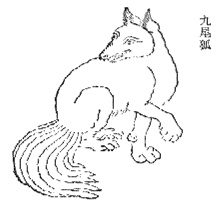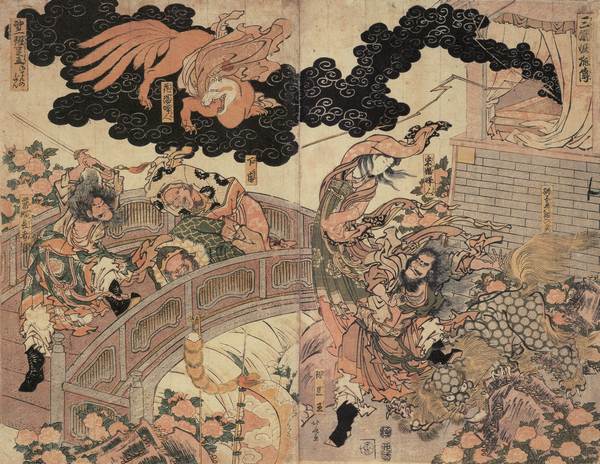Earlier on in the piece we had traveled to Otsu on the shores of Lake Biwa, half an hour out of Kyoto to watch the Otsu Matsuri, a festival like the one at Kakunodate. In the Otsu Matsuri, three wheeled two-storey high chariots made in the 1600s and 1700s, containing teams of ohayashi players of flutes drums and bells stirring on the floats, covered in ornate old tapestries, some from medieval Belgium, each with its own puppet theatre telling a different tale, often derived from a Noh play of a fable, are blessed at the Tenson Shrine, before being pulled around the town with frenzied energy by teams of men in Kimonos and loin cloths, again with a procession of the elders, priests, little girls and boys in costume, while at the same time throwing out good luck chimakis and scarves to the crowds, who vie with one another to pick up the prizes. You can read the plays portrayed in each of the pictured floats towards the end of the chapter.



Otsu Matsuri Video

































At the shrine the elders from each float approach the shrine priests with offerings in sealed black boxes.




























At certain points on the parade route there are places where the performance of the puppet plays are put on for the benefit of the judges overlooking from the second storey and spectators in the street. There is often a young girl present.








Saigyozakuratanuki-yama tells the legend of the mask of a raccoon dog worn by Shiour Jihei. The racoon dog crowning the float is regared as a guardian of the festival and a keeper of the fine weather.

The float tells the questions and answers exchanged between the monk Saigo and a phantom of a cherry tree.




Gekkyuden-zan tells the story of a Noh play in which the Chinese emperor performs a court dance of the Gekkyuden or palace of the moon as a blessing for health and life. In the puppet play a boy with a tortoise crown and a girl with a crane crown, offer a blessing of health and longevity.


Jingukogo-yama tells how Empress Jingu divined victory by catching ayu (sweet fish) and ended up winning the battle.


Kakkyo-yama the legend of the dutiful son who was so poor that he contemplated burying his son and having another because he was taking too much food needed by his irreplaceable grandmother. But when he digs the hole a pot of gold appears.



Tale of the Genji or Genji-monogatari, one of the greatest works of Japanese fiction, is told in the Genji-yama float. Written by Murskai Shikibu, said to be the world's first novelist of the 10th to 11th century, it tells the story of Prince Genji and his loves and descendents.




At the height of the parade coming down the narrow street, the men on board the float threw out chimakis, good luck charms made of folded bamboo leaves and rice straw. Everyone jumped forward and a man pushed Christine to the ground in his haste to grab one. Other people were embarrassed and sympathetic and then gave Christine two chimakis and a scarf of the nine-tailed fox from the Sesshoseki-zan float.
 The Sesshoseki-zan float with Tamamo-no-Mae in the background
The Sesshoseki-zan float with Tamamo-no-Mae in the backgroundA rock is split by the priests spiritual power
and the woman appears and transforms into the nine-tailed fox
According to Wikipedia, the nine-tailed fox is represented in various forms as Tamamo-no-Mae. Tamamo-no-Mae was a courtesan under the Japanese Emperor Konoe. She was said to be a most beautiful and intelligent woman. She caused the Emperor to be extremely ill and was chased away by Abe no Yasuchika, who had been called to diagnose the cause of the Emperor's poor health. Abe no Yasuchika discovered the true nature of Tamamo-no-mae. A few years later, in the area of Nasu, the nine-tailed fox was seen killing and eating women and travelers. Emperor Konoe thus sent Kazusa-no-suke and Miura-no-suke along with 80,000 troops to kill the fox. In the plains of Nasu, it was finally killed and became a stone called Sessho-seki that continued to release poisonous gas and kill everything that touched it. The stone was said to have been destroyed in the Nanboku-chō period by Gennoh Shinshou, and the pieces flew away to different parts of Japan.

 Our scarf of the nine-tailed fox with chimakis below
Our scarf of the nine-tailed fox with chimakis belowIn the story told by Hokusai, formed in the Edo period, the nine-tail fox (Kyūbi no Kitsune), which possessed Daji was not killed, but instead fled to Magadha of Tianzhu (ancient India). There, it became the concubine of a prince, causing him to cut off the heads of 1000 men. It was then defeated again, and fled the country. Around 780 BC, the same fox was said to have possessed Baosi and again chased away by human military forces.
 Shanhaijing illustration of Nine-tailed Fox, companion of Xi Wangmu
Shanhaijing illustration of Nine-tailed Fox, companion of Xi Wangmu
Versions of the text have existed since the 4th century BC
The fox stayed quiet for some period. In AD 753, the fox took the form of a 16 year old girl named Wakamo, fooled Kibi Makibi, Abe no Nakamaro, and Jianzhen, and boarded the ship of the 10th Japanese missions to Tang China when it was about to return to Japan. In 1113, a samurai called Sakabe Yukitsuna (坂部行綱) with no children picked up an abandoned baby girl Mizukume (藻女, girl of algae) which was actually the nine-tailed fox transformed, and raised her for 17 years. At the age of 18 she changed her name to Tamamo-no-Mae, entered the palace, and bewitched Emperor Konoe.
Versions of the text have existed since the 4th century BC
The fox stayed quiet for some period. In AD 753, the fox took the form of a 16 year old girl named Wakamo, fooled Kibi Makibi, Abe no Nakamaro, and Jianzhen, and boarded the ship of the 10th Japanese missions to Tang China when it was about to return to Japan. In 1113, a samurai called Sakabe Yukitsuna (坂部行綱) with no children picked up an abandoned baby girl Mizukume (藻女, girl of algae) which was actually the nine-tailed fox transformed, and raised her for 17 years. At the age of 18 she changed her name to Tamamo-no-Mae, entered the palace, and bewitched Emperor Konoe.
 Fleeing Kyubi as Lady Wah-yeung (華陽夫人) depicted in Hokusai's Sangoku Yōko-den (三国妖狐伝)
Fleeing Kyubi as Lady Wah-yeung (華陽夫人) depicted in Hokusai's Sangoku Yōko-den (三国妖狐伝)When we returned to NZ, our son brought us episodes of the anime series Naruto and our experience of the nine-tailed fox became a great continuing adventure.
In the modern manga and anime story by Masashi Kishimoto, Naruto, whose name echoes the whirlpool off Shikoku and Awaji, the kyuubi of the nine-tailed fox was sealed into the baby boy Naruto by his father when he fought Uchicha Madara to the death. The Jinchuriki Naruto thus becomes both the delinquent and hero of the series by overcoming his feelings of rejection by others and conquering the power of the kyuubi to become the protector and prospective Hokage of the Hidden Leaf Ninja Village.
In the modern manga and anime story by Masashi Kishimoto, Naruto, whose name echoes the whirlpool off Shikoku and Awaji, the kyuubi of the nine-tailed fox was sealed into the baby boy Naruto by his father when he fought Uchicha Madara to the death. The Jinchuriki Naruto thus becomes both the delinquent and hero of the series by overcoming his feelings of rejection by others and conquering the power of the kyuubi to become the protector and prospective Hokage of the Hidden Leaf Ninja Village.
 The Kyuubi sealed within Naruto in Masashi Kishimoto's manga and anime series.
The Kyuubi sealed within Naruto in Masashi Kishimoto's manga and anime series. Komeikisui-zan tells of a famous strategist who looked at flowing water while he fought the enemy Cao Cao and then prayed to the god of water to wash away his opponents and won.
Komeikisui-zan tells of a famous strategist who looked at flowing water while he fought the enemy Cao Cao and then prayed to the god of water to wash away his opponents and won.


Shakkyo-zan tells of the Noh play Shakkyo. A priest goes to China and enters Mt. Tiantaishan and when he tries to cross the bridge to the paradise of the Bodhisattva of Wisdom but a Chinese lion appears and frolicks among the peony flowers.




 Nishinomiya Ebisu-yama float Ebisu god of wealth and commerce
Nishinomiya Ebisu-yama float Ebisu god of wealth and commerce hangs out a fishing rod to catch creal and bream.
Seiobo-zan or Momoyama tells the story of a female hermit Seiobo of China who came down to this world with a celestial nymph. She met the emperor and offered him a peach celebrating his longlevity which blossoms only once every 3000 years and has only one fruit.





Ryumontaki-yama is derived from the ancient legend of the rapid waterfall in China which was too fast for fish to swim up but if it does it transforms into a dragon (bounteous fortune). In the animation, a golden fish struggles up the slope and changes to a dragon flapping its wings.


After the procession of chariots and puppet plays there was a procession through the town similar to the Kasuga matsuri where the priests ride on horseback and there are big drums and gods and processions of children in ceremonial dress.
















































